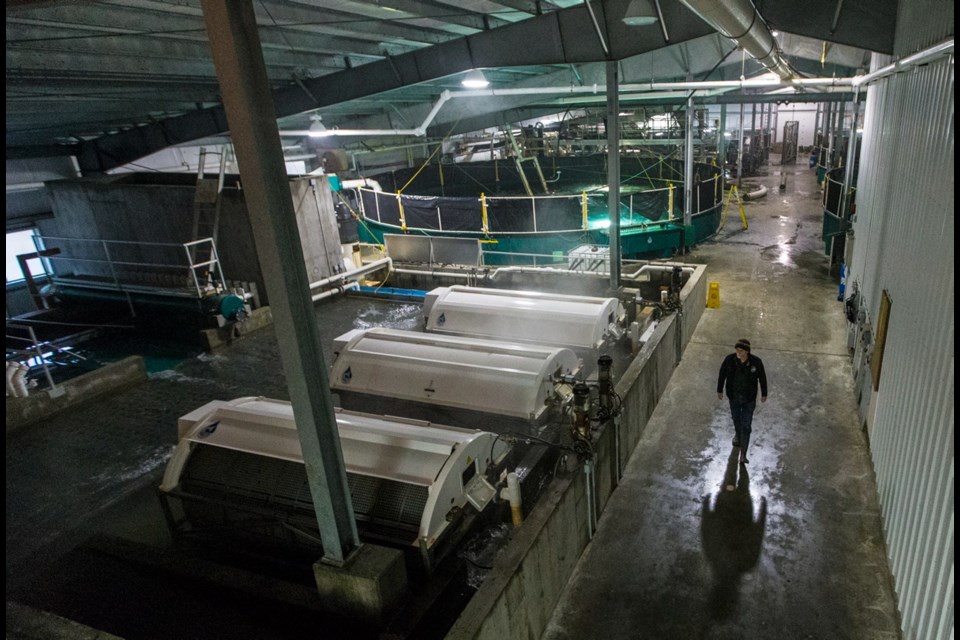In what looks like a giant hot tub, all bubbling water and underwater pot lights, hundreds of Atlantic salmon swim in a never-ending circle.
As long as your arm, the fish move elegantly, around and around and around.
These are the salmon upon which the future of British Columbia aquaculture might rest — fish raised not in controversial open-net pens in the ocean, but on land.
The ‘Namgis First Nation created Kuterra, the facility where the fish are raised just south of Port McNeill, as a place to experiment with land-based possibilities — the Model A of closed-containment fish farming.
“They came up with the idea: How about we come up with a new technology, a better way to growing these fish,” Kuterra CEO Garry Ullstrom said.
As an innovation experiment, the farm has been a success. Kuterra has proven Atlantic salmon can be raised on land. Three years after its first harvest, Kuterra says it’s operating with a “modest profit.”
The question is whether that profit is high enough. Based on its 2016 production, Kuterra’s fish cost 12 times as much to raise as the average for net-pen farms, said a report by analyst Brad Hicks. Some of that can be tied to the growing pains of a new technology, but even if Kuterra hits its target of 400 tonnes of fish a year, its salmon would still be seven times more expensive.
Capital costs are one big problem, but another is that the fish haven’t grown as large or as quickly as projected. In 2016, they averaged 2.4 kilograms compared with the target of six, Hicks said.
“I think the models overestimate the rate of growth, and that’s very key when you’re looking at the profitability of a system,” said Hicks, who was a technical adviser on Kuterra for funder Tides Foundation and is a board member for the B.C. Salmon Farmers Association.
Another consideration: Even if land-based aquaculture takes off, coastal Vancouver Island and British Columbia might have something to lose — the industry itself. Companies could move farms closer to markets or to places with lower labour costs.
“The net pens rely on British Columbia because it’s got the right environment to grow fish. Once you isolate the fish from the environment, they can be grown anywhere,” Hicks said.
“They certainly won’t be grown on Vancouver Island, just for the freight costs alone. You have to truck the feed up and you have to truck the fish out.”
In 2015, a total of 54,400 tonnes of farm-raised B.C. salmon were exported to 11 countries, while 20,600 tones were sold in Canada, according to the B.C. Salmon Farmers Association.
Others are more optimistic than Hicks about the potential of the industry. DNB Markets, a division of the Norwegian DNB Bank ASA, said the prospects for land-based farming worldwide have never looked better.
Biological concerns, tighter regulatory controls and licence costs in ocean-based farms are making land-based alternatives more attractive. New technology has cut the water used by land-based tanks by 99 per cent.
“Our findings suggest the technology has come further than generally expected, and setting up full-scale land-based operations can, under certain conditions, yield acceptable returns,” the DNB report says. It projected meaningful volumes from land-based farms by 2020.
If Kuterra is the Model A, one company is building the Ferrari of land-based salmon farms in Florida. At peak capacity, Atlantic Sapphire USA promises 90,000 tonnes of salmon annually — larger than the entire B.C. farmed-salmon industry.
‘Namgis elected chief Don Svanvik said to look at Kuterra as an economic model is to view it through the wrong lens. It was designed as a small-scale research and development project, not a template for other commercial operations.
“The reason this was built was to prove that you could do this on land and make some money. And we’ve done that,” Svanvik said.
After investing $4.5 million in the project, the ‘Namgis are looking for investors to take over majority ownership. The project could be more profitable if expanded, but the nation doesn’t have deep enough pockets to do so itself, Svanvik said.
“For it to continue, it has to be at a large scale. That was always a known thing,” he said.
Ullstrom said that Kuterra’s modelling shows that at 5,000 tonnes or more, an investor should expect about 20 per cent return on investment, he said.
He acknowledged there has been a learning curve at Kuterra, but said that’s expected for any start-up.
“I call it the ‘taming the technology period,’ ” he said.
“It took until November 2016, 3 1/2 years after we put the first fish in, to get the farm to a stable state where it’s delivering excellent water quality and excellent quality fish on a consistent kind of basis,” he said.
In the same time period, he said, Kuterra has busted myths about rearing land-based fish and found efficiencies.
Some assume a salmon raised in a contained pen would be less healthy, but Ullstrom said that’s not the case. It is protected from sea lice, jellyfish pathogens and diseases, meaning it can be raised organically and without antibiotics.
Through innovations, the plant is using less power and water than projected, he said. The fish waste is also composted in an environmentally friendly way, he said.
Kuterra continues to search for the perfect balance of salinity, temperature and scale to raise Atlantic salmon that can be competitive in the market.
“This facility was built so that we could learn as much as possible and address as many of the questions that had been asked about this technology as possible,” Ullstrom said.
“And we have now, finally, after getting to a steady state, been able to say it works.



